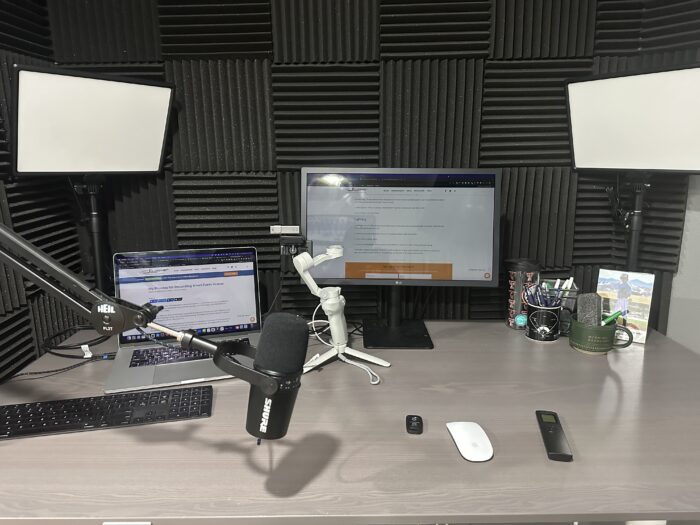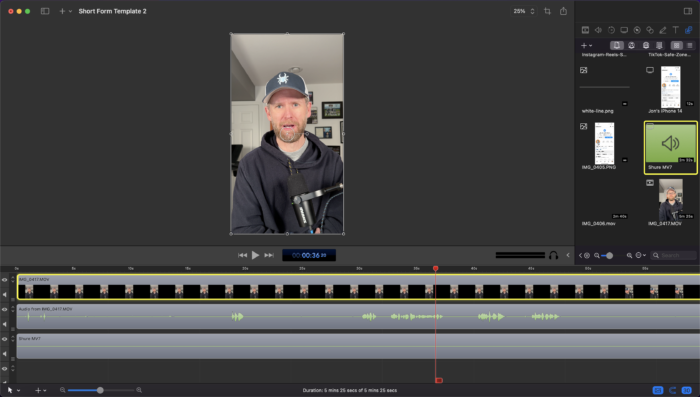I’ve recorded more than 270 videos (give or take) since I started my short-form video journey about six months ago. I’m often asked about my process for recording short-form videos, and I feel like this is a good time to do a reveal.
Truthfully, I didn’t feel all that comfortable saying much during most of this journey since I knew that I was still so early in figuring it all out. I was learning and evolving, and I knew that whatever process I had was likely to change as soon as I talked about it.
At this stage, though, I feel pretty good about the process I’m following. It’s consistent. I’m sure plenty will still change to how I do things over the next year and beyond, but the rate of change will likely slow. I’ve found what I like and what makes me efficient for now.
Below is my current process for recording my short-form videos. It’s not perfect. But it’s what works for me.
If you want to learn more about what I do and how to get started with short-form video, check out my new training course!
Scripting
I know there are a lot of theories on this, but I mostly don’t script anything.
Occasionally, I’ll write down some thoughts and I’ll even write out bullet points. But I truly think my videos are more conversational if I don’t have a script.
I have a goal in mind, of course. I know what I’m going to talk about. And then I talk.
I’ll get to that a bit more later.
Lighting
I won’t get into all of the details about lighting here because that’s a separate topic of its own, but here are three primary things that I do…
1. I turn on my two LED panels that are mounted on either side of my desk.

2. I turn off my ceiling lights.
3. I turn on my RGB light that’s laying on the floor for a splash of color to the walls and ceiling.
The RGB is unnecessary, but I’ve found it adds a little bit of style and variation. My videos are bound to look very similar to one another, so switching up the color every day tends to help.
My Camera (My Phone)
Some people are surprised to hear this, but the primary video source is my phone. It’s not a special DSLR or fancy camera.
Of course, I do use an iPhone 14 Pro, and I can see a noticeable improvement over my old iPhone 12. I also use the Cinematic video setting to make the background blurry and give it a bit of professional polish.
I perch my phone on a small tripod in front of me on my desk. I use the rear-facing camera because it produces slightly better quality. To do that, I connect my iPhone to my MacBook and open up QuickTime. I start a new video and select my phone so that I can see what I’m recording from there.
Many have reached out and told me that I don’t need to do it that way, but I do because I have an older MacBook from 2016. Newer ones can mirror to the laptop without hooking them up.
I use a little remote that once came with a tripod to start recording. Couldn’t cost more than $10.
Beyond that, I line everything up so that my desk doesn’t appear in the shot and my eyes land on the top horizontal line of the grid tool.
Screenflow Recording
While I record with my phone, I also record with Screenflow, a desktop video editing app.
Many people ask what I use for editing, and I’m always hesitant to tell them. The truth is that you can do the same thing with so many different apps, it really doesn’t matter. Use what you’re comfortable with. I’ve used Screenflow for more than a decade.
I record at least my external mic from Screenflow. This will replace my phone audio to improve the quality. If I’m doing a tutorial, I’ll also record my screen.
What that means is that we’ll have at least two files to work with when I’m editing. Since there will be audio from my phone’s video file, I will line up the phone’s audio with the audio from my external mic before deleting the phone’s audio file.

The Sit-Down
Here’s something you need to understand: While the final product is a clean edit, it was anything but that when I sat down and hit record.
I could create a blooper reel for every sit-down I do. I’m not kidding.
I know that this is one of the things that keeps people from creating videos. They see the final polish and they think that’s how it looked when it was recorded. That can be intimidating.
My original video files are anywhere from three to six minutes. And really, three and six almost never happen. It’s usually between four and five.
To recap from earlier, I set up my phone in front of me and hit record. I have a general idea of what I want to say, but I don’t script anything out. I just talk.
To simplify, I’m really thinking about the next sentence I want to say in my head. I’m not all that worried about the full message.
I know I’m not alone in this, but I fumble with my words a lot. I often need to attempt to say the same sentence five or six times. It’s frustrating, but that stuff gets edited out.
I say a sentence, and then pause and think. I say another sentence, pause, and think. I repeat it if it comes out awkwardly. Sometimes I say sentence fragments and pause and then complete the sentence. I can splice the fragments together later.
Editing
I won’t get into the details of my editing here, but just a few quick points.
I will cut that three to six-minute rough file down to no more than 60 seconds. No exceptions. You’ll find that many of my videos are 59+ seconds. This is not by accident.
After lining up the files, I make a first-pass edit. This is when I just clean up the mistakes and pauses.
Of course, that almost always results in a video that will be longer than a minute (typically 10 to 20 seconds over). That means I need to go back through and prioritize. This is where I take out parts that aren’t completely necessary to the message.
Once I get it down to 60 seconds, I then add a final polish with jump cuts and zoom video actions.
The final step is that I export that file and import it into CapCut to add the captions.
Scheduling and Publishing
I publish my videos to six different platforms (links to my profile for each):
It’s a lot. I’ve experimented with using various scheduling and repurposing apps, but I’m currently back to scheduling almost all of them natively. I just don’t find it takes all that much time to need a separate app.
There’s always the debate about whether third-party apps hurt your reach, too. Personally, I only have suspicions about YouTube Shorts. Whether a coincidence or not, I’ve seen that my videos consistently perform far better when scheduled or published natively from YouTube.
Not that my videos do great from YouTube. But I was regularly seeing 50 views or less per video when using a third-party app, but I consistently see more than that when scheduled natively.
Everything else is trial and error and personal preference. I publish at least once per day, and it’s typically in the morning.
Your Turn
Do you have any questions about my short-form video recording process? Ask it below.






